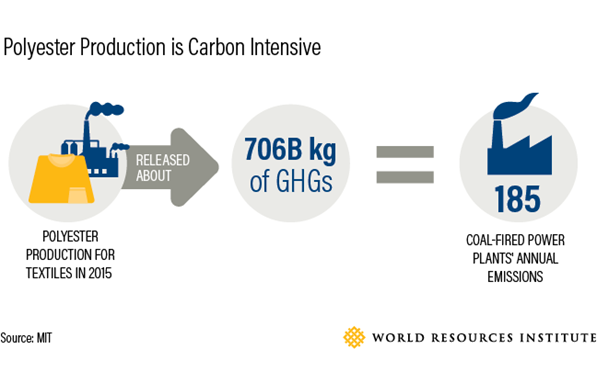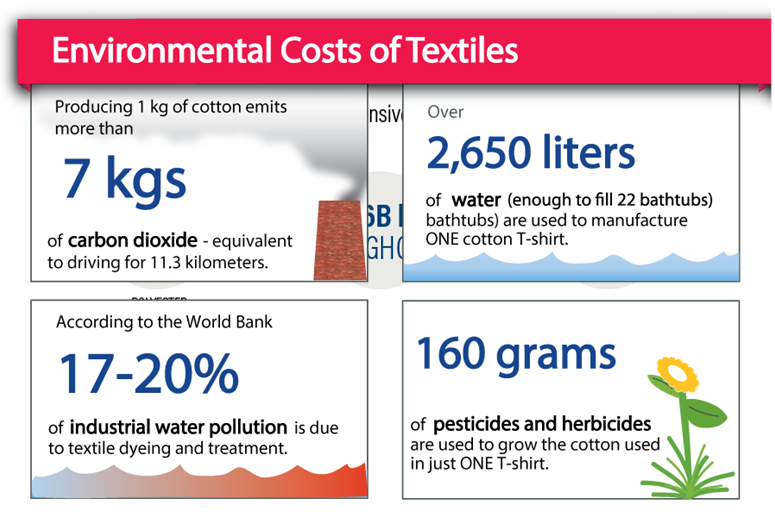Reducing Our Carbon Footprint
- THROUGH SUSTAINABLE TEXTILE MANUFACTURING
BY (Ms.) Madushi Hansika Medagedara
The textile industry which accounted for approximately $2.941 billion during the first seven months of 2021 (as per the statistics released by the Central Bank of Sri Lanka), however is the second most polluted industry in the world, thus having detrimental effects on the planet, while being a major source of income to our nation. Therefore, implementing sustainable proactive measures is a contemporary necessity to prolong the role Sri Lanka plays as the leading apparel solutions provider in South-East Asia.

Fig 1 - Impact of Polyester Production on the Carbon Footprint
Sustainability in its own terms can be addressed in a wider scope pertaining to socio-economic sustainability and environmental sustainability especially within the realms of the textile and apparel manufacturing industry. From sourcing raw material to processing, manufacturing, storing, logistics and even the consumer’s user cycle to disposal, measures can be taken to intervene and implement sustainability practices through engineering the processes involved in the product life cycle.
Sustainable sourcing practices involved in textile manufacturing, can be considered as integration of environmental, ethical, and social attributes throughout the entire sourcing process, including purchasing sustainable products and services. Sustainable sourcing strategies may also indirectly boost the economies of the countries in the long run. “Green Sourcing” has therefore become a major policy changer influenced by market intelligence to source sustainable and greener alternatives. Sourcing raw material that includes using less amounts of water, hazardous chemicals, pesticides, and fertilizers while introducing 3 Rs—Reduce, Reuse, and Recycle, to put circular economy into practice is one such initiative that can be applied to the sourcing procedure.
When considering the textile manufacturing process, this involves many stages; yarn spinning, fabric manufacturing, coloration and dyeing, fabric finishing etc. Reducing water and energy consumption using state of the art technologies can be considered as such sustainable practices.

Fig 2 - Environmental cost of Textiles
 Dyeing and finishing of textiles is one process that constitutes towards most of the pollution in terms of its emission of greenhouse gases and wastewater with pollutants. The high temperatures and pressure required by the dyeing machines, the chemicals that are used, high water consumption and the gaseous emissions can be held in account for this regard. Additionally, the use of non-biodegradable petroleum-based colorants to dye textiles, the use of toxic agents to fix colorants on the textiles, and the release of large proportions of these colorants and fixation agents into the surrounding causes pernicious effects to the ecosystem.
Dyeing and finishing of textiles is one process that constitutes towards most of the pollution in terms of its emission of greenhouse gases and wastewater with pollutants. The high temperatures and pressure required by the dyeing machines, the chemicals that are used, high water consumption and the gaseous emissions can be held in account for this regard. Additionally, the use of non-biodegradable petroleum-based colorants to dye textiles, the use of toxic agents to fix colorants on the textiles, and the release of large proportions of these colorants and fixation agents into the surrounding causes pernicious effects to the ecosystem.
Technologies such as Super Critical dyeing (waterless dyeing), natural color extraction from biodegradable sources, pigments and auxiliaries that require low salt and water uptakes, natural or engineered micro-organisms as catalysts to reduce operating temperature and pressures, are several developments that can be implemented as sustainability measures. Moreover, sustainable dyeing practices such as RFT (Right First-time dyeing) where the correct dyeing shade is achieved at one go reduces the carbon footprint while improving the production efficiency.
ZLD Or Zero discharge system is another implementation which refers to treating effluent water in such a manner such that the effluent water will be free from TDS (total dissolved solid) and free from any other impurities. Therefore, the main aim is to recover usable materials such as water and salt from effluents and minimize the generation of waste so that it can be safely stored on-site without the need for discharging into the environment. Thus, the Zero liquid discharge (ZLD) is a strategic wastewater management system that ensures that there will be no discharge of industrial wastewater into the environment except solid waste.

Furthermore, taking steps in the manufacturing process to engineer the product life cycle such that product longevity is enhanced to ensure that normal wear and tear is reduced and consequently the product would remain with the consumer a longer time is another sustainability practice that the industry is currently implementing. Fast fashion is slowly being discouraged by major brands to facilitate this purpose.
It has been forecasted that by 2030, there will be 5.4 billion people in the with a fair disposable income leading to increased demand for apparels. As one of the world’s largest consumer industries, the fashion industry has a 1.5 trillion-euro market with over 300 million people across its value chain, therefore sustainable manufacturing is inevitably a contemporary necessity that should be practiced as a nation that caters to global brands as a total apparel solutions provider.
References & Image Sources
https://www.bsr.org/reports/BSR_Apparel_Supply_Chain_Carbon_Report.pdf
https://proqc.com/blog/environmental-impacts-solutions-within-the-textile-garment-industry/
http://www.fashion-reindustrialization.hk/en/3-1-environmental-impacts/
https://www.planetaid.org/blog/the-apparel-industrys-environmental-impact-in-six-graphics
https://www.prescouter.com/2018/11/sustainable-dyeing-innovations-greener-ways-color-textiles
 Eng. (Ms.) Madushi Hansika Medagedara
Eng. (Ms.) Madushi Hansika Medagedara
Eng. (Ms.) Madushi Hansika Medagedara graduated with B.Sc. Eng. (Hons) in Textile & Apparel Engineering (Specialized in Technical Textiles) from the University of Moratuwa. She is currently employed as a Technology Entrepreneur in the Open Innovations HUB, Twinery, MAS Innovations Pvt Ltd. She is a Member of Institution of Engineers Sri Lanka (IESL) and a member of the Sri Lanka Association for the Advancement of Science (SLAAS).




